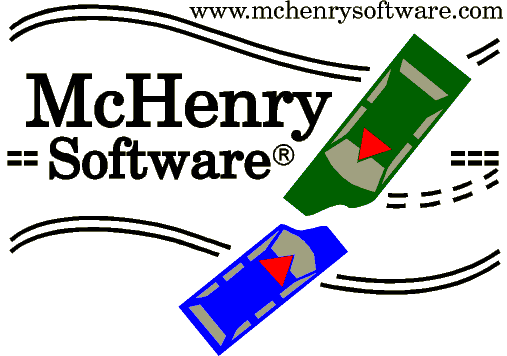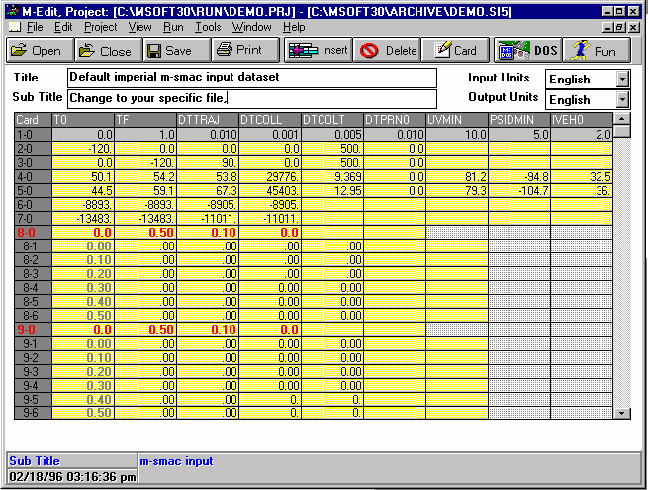

AUGUST 2008: Please see our announcement for medit32.
The McHenry-Edit Environment (m-edit) user interface is an Integrated Analysis Environment (IAE) that runs with the Microsoft Windows operating system. It integrates the following components into a cohesive collection which provides for complete accident reconstruction analysis including:
Other Integrated Analysis Environment Functions

The McHenry-Edit Environment m-edit is a specialized Multiple Document Interface (MDI) container for the Microsoft Windows operating system. An MDI provides for the ability to open multiple files (documents) simultaneously from the m-edit environment to create, edit, execute, view and print outputs and graphics for computer simulation programs related to Accident Reconstruction Software by McHenry Software, Inc. The suite includes the m-smac (available now!), m-hvosm (available ~mid 1997) and m-crash (available ~mid 1997) simulation programs, their corresponding graphics and animation programs, m-smacgr, m-smacan, and m-hvgr, and a number of other auxiliary reconstruction analysis programs: Customized Windows-based NHTSA vehicle specifications, NHTSA crash test and Canadian SPECS database browsers, Launch, Marquard, etc. The m-edit also has an intelligent editor for the creation of m-smac and m-hvosm program inputs.
The m-smac / m-hvosm Intelligent editor is an input editor for the m-smac / m-hvosm programs which recognizes the input variables by location (card number and field number) and displays information automatically while you are editing. m-edit checks that the input values are within a reasonable range and insures that the input data deck is in the proper format for use with the m-smac / m-hvosmsimulation program. The editor also includes a pop-up form editor for individual fields and/or cards:

The basis and rationale for card editing stems from the origins of the SMAC and HVOSM programs. The Simulation Model of Automobile Collisions (SMAC, ref. 1) and the Highway Vehicle Object Simulation Model (HVOSM, ref. 3.) program were originally developed at Calspan Corporation (formerly the Cornell Aeronautical Lab) in the late 1960's through the early 1970's. The original computer platform for the development and execution of the SMAC and HVOSM programs was the IBM 370, an IBM mainframe computer. The original form of the input to the IBM 370 for the SMAC and HVOSM programs were punched card decks (i.e., stacks of cards, each containing one data line, 80 columns wide, which was for FORTRAN program input normally subdivided into 9 fields, each eight columns wide, plus a card sequence number and card number ID in the last 8 columns. Of course the card sequence number and card number ID were particularly important if you inadvertently dropped the data deck!)
With the evolution of mini and micro computers and Graphical User Interface (GUI) programming, many programs have opted to discard the card data deck type of input. This has resulted in programs which sometimes require extensive navigation to get to the page which contains the variable you wish to edit. Normally input datasets created and maintained for GUI interfaces are saved in database format, a sometimes cryptic form (normally numbers separated by delimiters, either tabs or commas, in a sequence customized for a particular program). With this type of interface normally the dataset does not lend itself to manual recognition or editing. On the other hand, a dataset organized similar to a punched card deck avoids the GUI navigation problems and permits the user, if they are so inclined, to view and/or edit the input data deck with any text editor.
McHenry Software, Inc. has chosen to retain the original format of a card deck as inputs to the m-smac and m-hvosm programs (in the form of an ASCII sequential disk dataset) for the following reasons:
The m-edit program promotes familiarization with the card input format and card field identification so that the experienced user can recognize and edit m-smac and m-hvosm input datasets independent of the m-edit environment, if they are so inclined.
The m-edit environment also provides pop-up forms which provides additional detail on the individual cards.
The m-edit environment then provides an Integrated Analysis Environment (IAE) which allows the user to execute programs, view outputs, view graphics and print all from within the IAE. The IAE has been designed to provide a total solution for creating and managing multiple projects which use multiple programs.
©McHenry Software,
Inc,